Zhuoyang Liu
MLA: A Multisensory Language-Action Model for Multimodal Understanding and Forecasting in Robotic Manipulation
Sep 30, 2025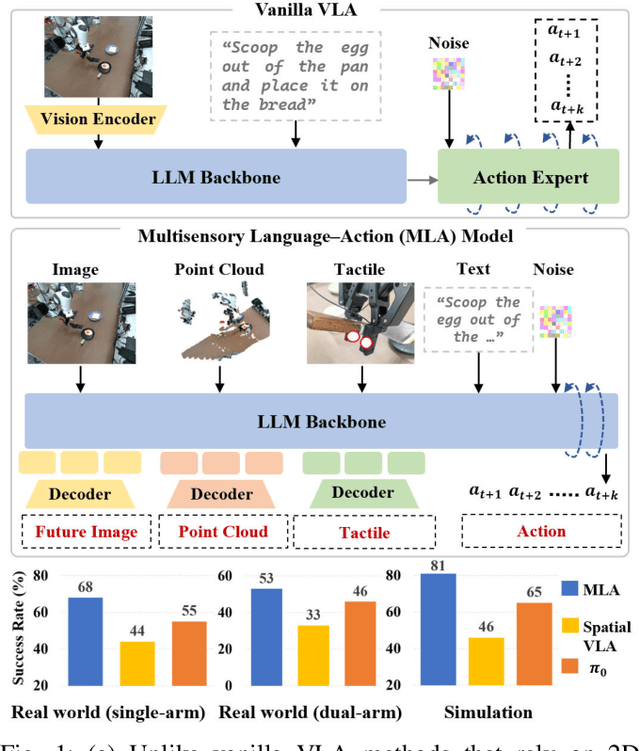
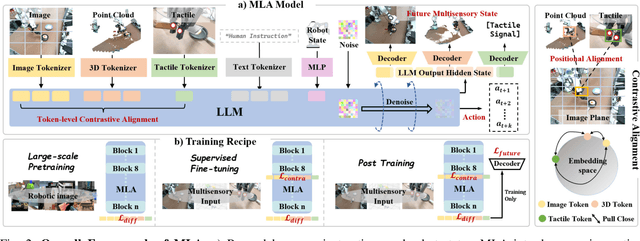

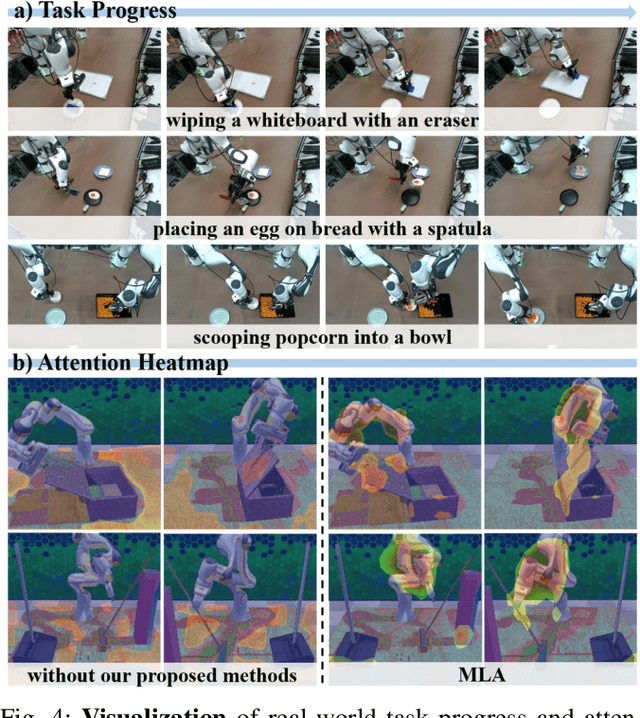
Abstract:Vision-language-action models (VLAs) have shown generalization capabilities in robotic manipulation tasks by inheriting from vision-language models (VLMs) and learning action generation. Most VLA models focus on interpreting vision and language to generate actions, whereas robots must perceive and interact within the spatial-physical world. This gap highlights the need for a comprehensive understanding of robotic-specific multisensory information, which is crucial for achieving complex and contact-rich control. To this end, we introduce a multisensory language-action (MLA) model that collaboratively perceives heterogeneous sensory modalities and predicts future multisensory objectives to facilitate physical world modeling. Specifically, to enhance perceptual representations, we propose an encoder-free multimodal alignment scheme that innovatively repurposes the large language model itself as a perception module, directly interpreting multimodal cues by aligning 2D images, 3D point clouds, and tactile tokens through positional correspondence. To further enhance MLA's understanding of physical dynamics, we design a future multisensory generation post-training strategy that enables MLA to reason about semantic, geometric, and interaction information, providing more robust conditions for action generation. For evaluation, the MLA model outperforms the previous state-of-the-art 2D and 3D VLA methods by 12% and 24% in complex, contact-rich real-world tasks, respectively, while also demonstrating improved generalization to unseen configurations. Project website: https://sites.google.com/view/open-mla
AC-DiT: Adaptive Coordination Diffusion Transformer for Mobile Manipulation
Jul 02, 2025Abstract:Recently, mobile manipulation has attracted increasing attention for enabling language-conditioned robotic control in household tasks. However, existing methods still face challenges in coordinating mobile base and manipulator, primarily due to two limitations. On the one hand, they fail to explicitly model the influence of the mobile base on manipulator control, which easily leads to error accumulation under high degrees of freedom. On the other hand, they treat the entire mobile manipulation process with the same visual observation modality (e.g., either all 2D or all 3D), overlooking the distinct multimodal perception requirements at different stages during mobile manipulation. To address this, we propose the Adaptive Coordination Diffusion Transformer (AC-DiT), which enhances mobile base and manipulator coordination for end-to-end mobile manipulation. First, since the motion of the mobile base directly influences the manipulator's actions, we introduce a mobility-to-body conditioning mechanism that guides the model to first extract base motion representations, which are then used as context prior for predicting whole-body actions. This enables whole-body control that accounts for the potential impact of the mobile base's motion. Second, to meet the perception requirements at different stages of mobile manipulation, we design a perception-aware multimodal conditioning strategy that dynamically adjusts the fusion weights between various 2D visual images and 3D point clouds, yielding visual features tailored to the current perceptual needs. This allows the model to, for example, adaptively rely more on 2D inputs when semantic information is crucial for action prediction, while placing greater emphasis on 3D geometric information when precise spatial understanding is required. We validate AC-DiT through extensive experiments on both simulated and real-world mobile manipulation tasks.
H2R: A Human-to-Robot Data Augmentation for Robot Pre-training from Videos
May 17, 2025Abstract:Large-scale pre-training using videos has proven effective for robot learning. However, the models pre-trained on such data can be suboptimal for robot learning due to the significant visual gap between human hands and those of different robots. To remedy this, we propose H2R, a simple data augmentation technique that detects human hand keypoints, synthesizes robot motions in simulation, and composites rendered robots into egocentric videos. This process explicitly bridges the visual gap between human and robot embodiments during pre-training. We apply H2R to augment large-scale egocentric human video datasets such as Ego4D and SSv2, replacing human hands with simulated robotic arms to generate robot-centric training data. Based on this, we construct and release a family of 1M-scale datasets covering multiple robot embodiments (UR5 with gripper/Leaphand, Franka) and data sources (SSv2, Ego4D). To verify the effectiveness of the augmentation pipeline, we introduce a CLIP-based image-text similarity metric that quantitatively evaluates the semantic fidelity of robot-rendered frames to the original human actions. We validate H2R across three simulation benchmarks: Robomimic, RLBench and PushT and real-world manipulation tasks with a UR5 robot equipped with Gripper and Leaphand end-effectors. H2R consistently improves downstream success rates, yielding gains of 5.0%-10.2% in simulation and 6.7%-23.3% in real-world tasks across various visual encoders and policy learning methods. These results indicate that H2R improves the generalization ability of robotic policies by mitigating the visual discrepancies between human and robot domains.
HybridVLA: Collaborative Diffusion and Autoregression in a Unified Vision-Language-Action Model
Mar 13, 2025Abstract:Recent advancements in vision-language models (VLMs) for common-sense reasoning have led to the development of vision-language-action (VLA) models, enabling robots to perform generalized manipulation. Although existing autoregressive VLA methods leverage large-scale pretrained knowledge, they disrupt the continuity of actions. Meanwhile, some VLA methods incorporate an additional diffusion head to predict continuous actions, relying solely on VLM-extracted features, which limits their reasoning capabilities. In this paper, we introduce HybridVLA, a unified framework that seamlessly integrates the strengths of both autoregressive and diffusion policies within a single large language model, rather than simply connecting them. To bridge the generation gap, a collaborative training recipe is proposed that injects the diffusion modeling directly into the next-token prediction. With this recipe, we find that these two forms of action prediction not only reinforce each other but also exhibit varying performance across different tasks. Therefore, we design a collaborative action ensemble mechanism that adaptively fuses these two predictions, leading to more robust control. In experiments, HybridVLA outperforms previous state-of-the-art VLA methods across various simulation and real-world tasks, including both single-arm and dual-arm robots, while demonstrating stable manipulation in previously unseen configurations.
Holographic Intelligence Surface Assisted Integrated Sensing and Communication
Jun 07, 2024



Abstract:Traditional discrete-array-based systems fail to exploit interactions between closely spaced antennas, resulting in inadequate utilization of the aperture resource. In this paper, we propose a holographic intelligence surface (HIS) assisted integrated sensing and communication (HISAC) system, wherein both the transmitter and receiver are fabricated using a continuous-aperture array. A continuous-discrete transformation of the HIS pattern based on the Fourier transform is proposed, converting the continuous pattern design into a discrete beamforming design. We formulate a joint transmit-receive beamforming optimization problem for the HISAC system, aiming to balance the performance of multi-target sensing while fulfilling the performance requirement of multi-user communication. To solve the non-convex problem with coupled variables, an alternating optimization-based algorithm is proposed to optimize the HISAC transmit-receive beamforming in an alternate manner. Specifically, the transmit beamforming design is solved by decoupling into a series of feasibility-checking sub-problems while the receive beamforming is determined by the Rayleigh quotient-based method. Simulation results demonstrate the superiority of the proposed HISAC system over traditional discrete-array-based ISAC systems, achieving significantly higher sensing performance while guaranteeing predetermined communication performance.
Physics-assisted Deep Learning for FMCW Radar Quantitative Imaging of Two-dimension Target
Jul 05, 2023Abstract:Radar imaging is crucial in remote sensing and has many applications in detection and autonomous driving. However, the received radar signal for imaging is enormous and redundant, which degrades the speed of real-time radar quantitative imaging and leads to obstacles in the downlink applications. In this paper, we propose a physics-assisted deep learning method for radar quantitative imaging with the advantage of compressed sensing (CS). Specifically, the signal model for frequency-modulated continuous-wave (FMCW) radar imaging which only uses four antennas and parts of frequency components is formulated in terms of matrices multiplication. The learned fast iterative shrinkage-thresholding algorithm with residual neural network (L-FISTA-ResNet) is proposed for solving the quantitative imaging problem. The L-FISTA is developed to ensure the basic solution and ResNet is attached to enhance the image quality. Simulation results show that our proposed method has higher reconstruction accuracy than the traditional optimization method and pure neural networks. The effectiveness and generalization performance of the proposed strategy is verified in unseen target imaging, denoising, and frequency migration tasks.
Hybrid RIS-Assisted MIMO Dual-Function Radar-Communication System
Mar 28, 2023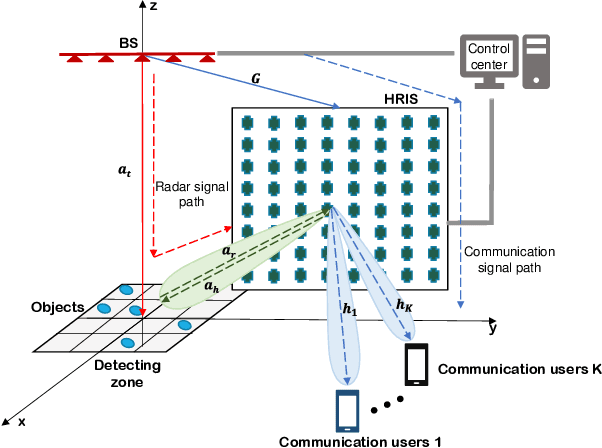
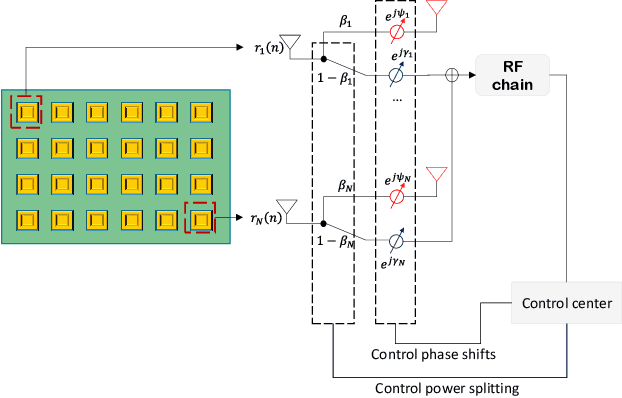
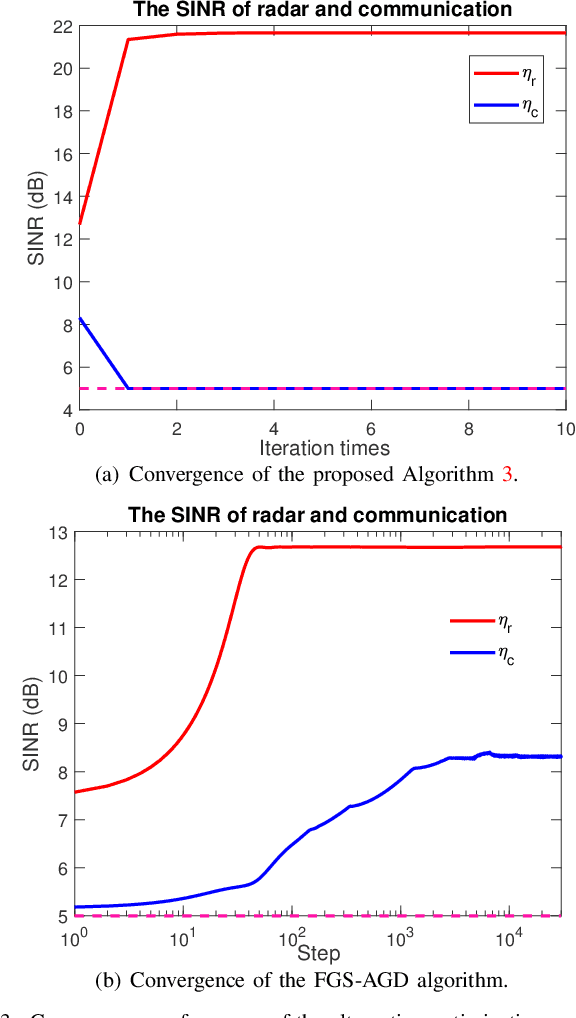
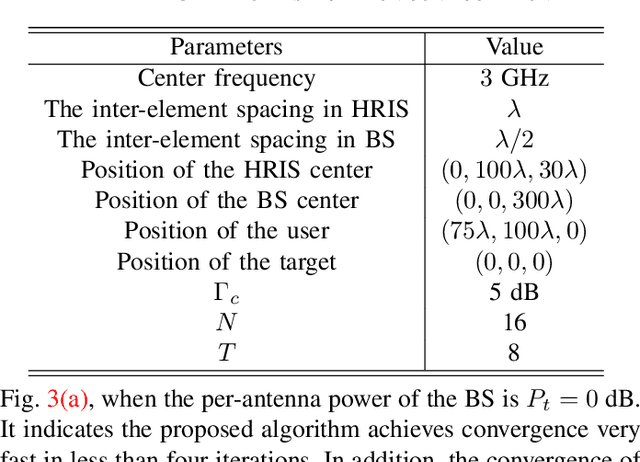
Abstract:Dual-function radar-communication (DFRC) technology is emerging in next-generation wireless systems. Reconfigurable intelligent surface (RIS) arrays have been suggested as a crucial sensor component of the DFRC. In this paper, we propose a hybrid RIS (HRIS)-assisted multiple-input multiple-output (MIMO) DFRC system, where the HRIS is capable of reflecting communication signals to mobile users and receiving the scattering signal reflected from the radar target simultaneously. Under such a scenario, we are interested in characterizing the fundamental trade-off between radar sensing and communication. Specifically, we study the joint design of the beamforming vectors at the base station (BS) and the parameter configuration of the HRIS so as to maximize the signal-to-interference-and-noise ratio (SINR) of the radar while guaranteeing a communication SINR requirement. To solve the formulated non-convex beamforming design problem, we propose an efficient alternating optimization approach. In particular, for fixed beams at the BS, we use a fast grid search-assisted auto gradient descent (FGS-AGD) algorithm to seek the best HRIS configuration; Then, a closed-form BS beamforming solution is obtained using semidefinite relaxation. Numerical results indicate that compared with benchmark schemes, the proposed approach is capable of improving the radar performance and communication quality significantly and simultaneously.
 Add to Chrome
Add to Chrome Add to Firefox
Add to Firefox Add to Edge
Add to Edge